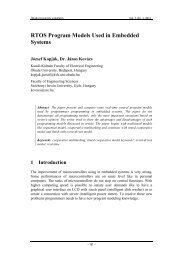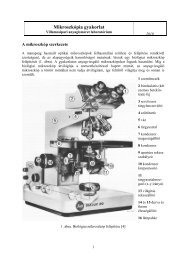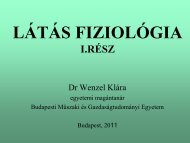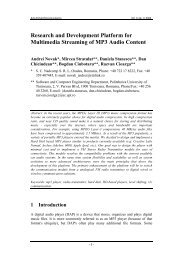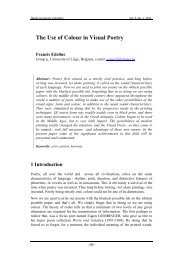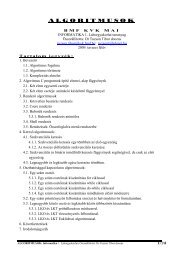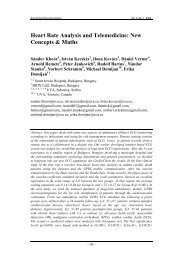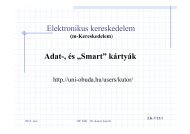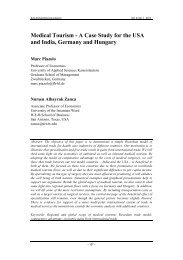Twin Concept of Fine Structure Constant as the 'Self Number ...
Twin Concept of Fine Structure Constant as the 'Self Number ...
Twin Concept of Fine Structure Constant as the 'Self Number ...
You also want an ePaper? Increase the reach of your titles
YUMPU automatically turns print PDFs into web optimized ePapers that Google loves.
P. Várlaki et al. <strong>Twin</strong> <strong>Concept</strong> <strong>of</strong> <strong>Fine</strong> <strong>Structure</strong> <strong>Constant</strong> <strong>as</strong> <strong>the</strong> ‘Self <strong>Number</strong>-Archetype’ Part I: Observation, …<br />
“Now <strong>the</strong>re comes <strong>the</strong> major crisis <strong>of</strong> <strong>the</strong> quantum <strong>of</strong> action: one h<strong>as</strong> to sacrifice<br />
<strong>the</strong> unique individual and <strong>the</strong> “sense” <strong>of</strong> it in order to save an objective and rational<br />
description <strong>of</strong> <strong>the</strong> phenomena. If two observers do <strong>the</strong> same thing even<br />
physically it is, indeed, really no longer <strong>the</strong> same: only <strong>the</strong> statistical averages<br />
remain, in general, <strong>the</strong> same. The physically unique individual is no longer separable<br />
from <strong>the</strong> observer – and for this re<strong>as</strong>on it goes through <strong>the</strong> meshes <strong>of</strong> <strong>the</strong> net<br />
<strong>of</strong> physics. The individual c<strong>as</strong>e is occ<strong>as</strong>io and not causa. I am inclined to see in<br />
this occ<strong>as</strong>ion which includes within itself <strong>the</strong> observer and <strong>the</strong> selection <strong>of</strong> <strong>the</strong> experimental<br />
procedure which he h<strong>as</strong> hit upon – a revenue <strong>of</strong> <strong>the</strong> anima mundi<br />
which w<strong>as</strong> pushed <strong>as</strong>ide in <strong>the</strong> seventeenth century (naturally “in an altered<br />
form”). La donna e mobile – so are <strong>the</strong> anima mundi and <strong>the</strong> occ<strong>as</strong>ion. Here<br />
something h<strong>as</strong> remained open which previously appeared to be closed, and it is<br />
my hope that new concepts, which are uniformly simultaneously physical and<br />
“psychological” (concerning <strong>the</strong> undetached observer), can force <strong>the</strong>mselves<br />
through this gap in place <strong>of</strong> “parallelism”. May “more successful <strong>of</strong>fspring” attain<br />
this.” [32]<br />
References<br />
[1] Ádám, A., Jánossy, L., Varga, P.: Acta Phys. Hung. 4, 301 (1955)<br />
[2] Anderson, C.: The Positive Electron. Phys. Rev. 43, 491 (1933)<br />
[3] Antoul<strong>as</strong>, A. (ed.): Ma<strong>the</strong>matical System Theory. Influence <strong>of</strong> R. E. Kalman.<br />
Springer Verlag (1991)<br />
[4] Aspect, A., Dalibard, J., Roger, G.: Experimental Test <strong>of</strong> Bell’s Inequalities<br />
Using Time-Varying Analyzers. Phys. Rev. Lett. 49(25), 1804 (1982)<br />
[5] Atmanschpacher, H., et al. (eds.): Der Pauli–Jung-Dialog und seine<br />
Bedeutung für die moderne Wissenschaft. Springer Verlag, Berlin (1995)<br />
[6] Miller, I. A. Deciphering <strong>the</strong> Cosmic <strong>Number</strong> The Strange Friendship <strong>of</strong> W.<br />
Pauli and C. G. Jung, W. W. Norton, New York London, 2009<br />
[7] Bokor, J., Keviczky, L.: Topics in Stoch<strong>as</strong>tic Systems: Modelling, Estimation<br />
and Adaptive Control, chap. Parametrizations <strong>of</strong> Linear Stoch<strong>as</strong>tic Systems,<br />
pp. 47-65, Lecture Notes in Control and Informations Sciences Series<br />
161, Springer Verlag (1991)<br />
[8] Bokor, J., Nádai, L.: Controllability <strong>of</strong> Quantum Bits – from <strong>the</strong> von Neumann<br />
Architecture to Quantum Computing. In: 3 rd Intl. Conference on<br />
Computational Intelligence and Intelligent Informatics. Agadir, Morocco<br />
(2007) On CD-ROM<br />
[9] Bonyhai, G.: Description and Interpretation. Filológiai Közlöny 1, 42-57<br />
(1975). In Hungarian<br />
[10] Bonyhai, G.: Gesetzm<strong>as</strong>sigkeit und Zufall. Beitrage zu Thom<strong>as</strong> Manns<br />
Schaffensmethode. Acta Literaria 1-2, 135-155 (1975)<br />
– 104 –



